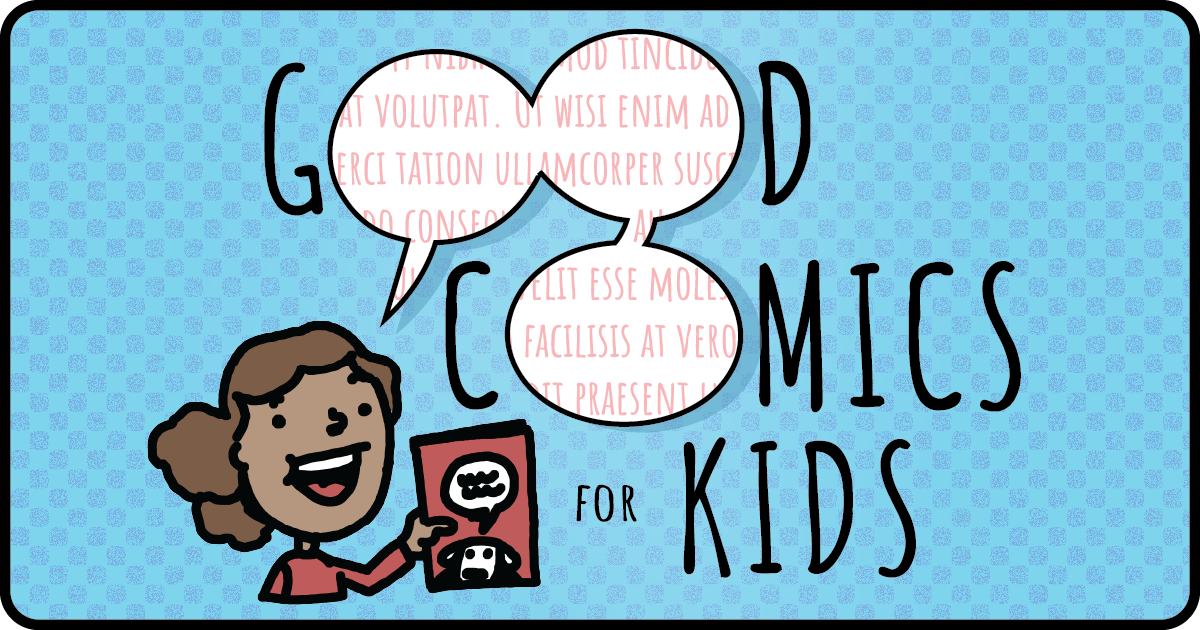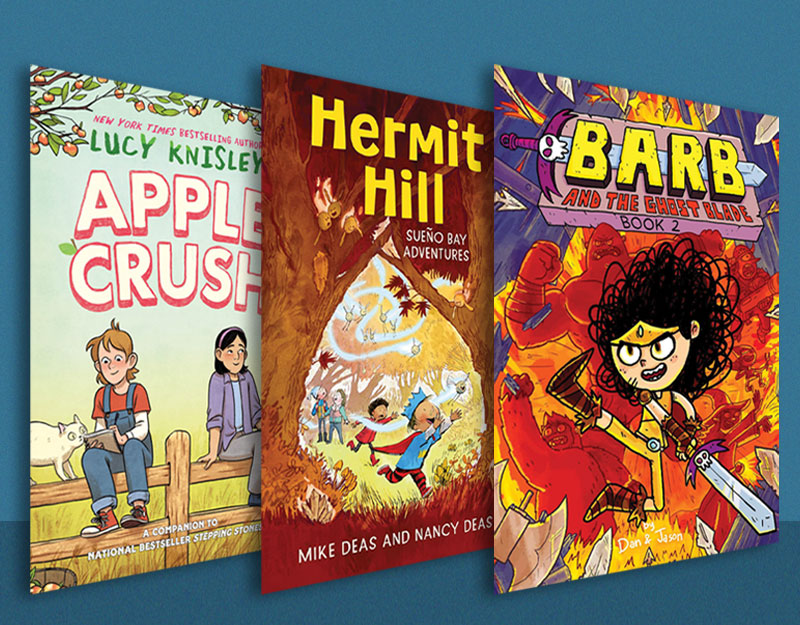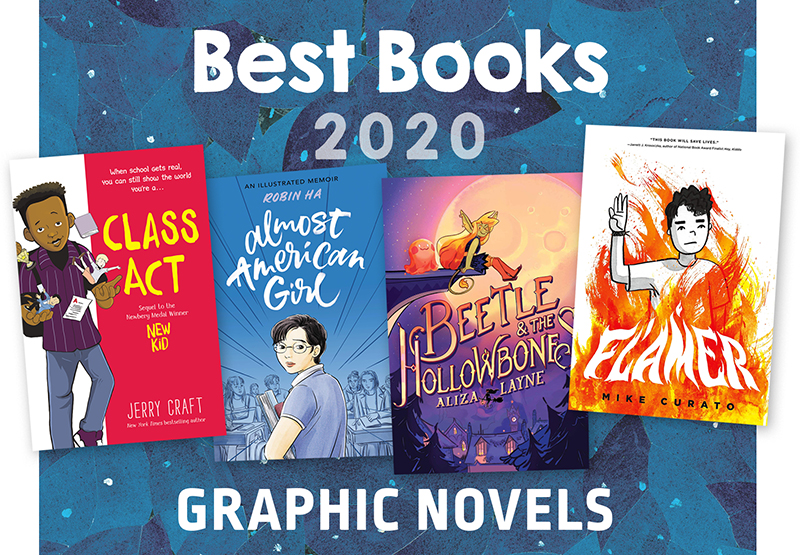Review: Turning Points Series from Aladdin
Historical fiction is not a genre that shows up often in graphic novels, which has always seemed odd to me. After all, one of the issues of understanding history is the need to be able to identify with people who live in places and times not like your own. Graphic novels have traditionally done a great job of getting the reader to believe in places of fantasy, so why wouldn’t they be an excellent medium for historical fiction? Aladdin, an imprint of Simon and Schuster, has begun to add to the genre of historical fiction graphic novels with their series Turning Points. These books are set in "moments in…history when decisions are made and actions are taken that will change the course of…" the future. By sticking with one author, Aladdin insures consistency of writing, though the three books each have a different feel to them.
 Sons of Liberty
Sons of Liberty
Written by Marshall Poe, illustrated by Leland Purvis
Aladdin Paperbacks, (c)2008
ISBN 978-1-4169-5067-7, $7.99
ages 10-14; grades 5-8
Nathaniel Smithfield lives with his father, mother, and sister in Boston in 1768. Though his father is trying hard to remain loyal to the British crown, Nathaniel and his sister can see that change is coming. When things come to a head between the British soldiers and the American colonists, the family must decide where their allegiance lies.
ADVERTISEMENT
ADVERTISEMENT
The Revolutionary War has always been a compelling theme for historical fiction, but unfortunately it is the setting for the weakest of the three titles. This is mainly due to Poe attempting to cover too much time in too short of a book. The other weakness is that readers must know a lot about the events leading up to the Revolutionary War in order to understand Nathaniel’s story. For readers with only a passing knowledge of those events, the story reads as choppy and dry in points. Poe also tries to cover too many years (1768-1776) in only 120 pages and the speeding through time weakens the story by not giving readers enough time to process events or bond with characters.
Purvis favors simple panel layouts, usually just three wide ones on each page, but their simplicity isn’t a weakness. He plays with the focus in each panel enough to keep things interesting and the pages of the book are small enough where having simple layouts keeps things visually cleaner. His art has a rough reality to it which helps highlight the seriousness of the story he is illustrating. Unfortunately in many of the daytime scenes, especially the crowd scenes outdoors, the pictures are just lines, with no shading. This makes the individual characters hard to distinguish and the story harder to follow. By the end of the volume, Purvis is using more shading and things are clearer.
 A House Divided
A House Divided
Written by Marshall Poe, illustrated by Leland Purvis
Aladdin Paperbacks, (c)2008
ISBN 978-1-4169-5057-8, $7.99
ages 10-14; grades 5-8
Brothers Owen and Amos Bennington are orphaned when their parents are killed in 1856. They are both determined to carry on their parents’ abolitionist work, but they are divided on how best to do so. Owen, the eldest, decides to throw his lot in with the young senator Abraham Lincoln in his quest for the presidency. Amos, however, favors a more direct approach and joins up with John Brown and his rag-tag army.
Poe seems to have gotten his feet under him in this volume. One of the strongest points of this book (and of the series) is that Poe doesn’t neglect to tell both sides of a story as much as he can. John Brown is shown as both a preacher with an amazing gift for motivating men and as a madman. Lincoln is show as the awkward, ungainly man that made many people laugh at his country bumpkin ways, but also as the talented orator that he was. Poe also covers Lincoln’s take on slavery. At one point a character says of Lincoln: "He’s not an abolitionist. He has said so! He thinks that slavery will come to end on its own." Very true and an important point that helps round out the history of the series. The parallels between Amos and Owen’s struggles and the struggles of the United States in the late 1850s are clear, but not overstated, as are the parallels between Lincoln’s work and John Brown’s mission. Purvis’ art is also stronger in this volume. He has the same rough, but strong lines and simple panel layouts as in Sons of Liberty, but his use of shading makes the art a lot easier on the eyes.
 Little Rock Nine
Little Rock Nine
Written by Marshall Poe, illustrated by Ellen Lindner
Aladdin Paperbacks, (c)2008
ISBN 978-1-4169-5066-0, $7.99
ages 10-14; grades 5-8
ADVERTISEMENT
ADVERTISEMENT
High school students William and Thomas live in the same town, but their lives are very different. William is white and goes to Little Rock Central High School, whereas Thomas, who is black, goes to the black high school. The previous year Thomas had been part of a group that tried to integrate Central High, but now, in August 1957 with the Supreme Court forcing integration, he must decide if the pain and humilation he suffered previously is worth going through again. William, meanwhile, is caught between his progressive father who is helping integration and his grandfather who firmly believes that the races should never mix.
Of all three volumes in this series, this one was my favorite. Poe’s insistance on showing as many sides of a story as possible succeeds admirably here, resulting in two main character who are believable boys caught up in a storm they don’t quite understand and aren’t sure that they’re strong enough to face. William and Thomas’ budding friendship does feel a little innocent for two boys well into their teens, but it is realistically based on shared interests and experiences, not simply on the author’s need to have them bond. The secondary characters are a mix that would have been found in the South at that time, from racists to integration supporters to those who aren’t sure exactly what they believe. In case you are wondering, yes the n-word is used. Thomas uses it three times as he is trying to help the other integrating students get used to the humilation and attacks they are going to experience. It is used completely appropriately and fits in the story without being jarring or forced.
Lindner’s art is very different from Purvis’. She has a modern, thin-lined style that at first seemed too cartoonish to me. As I read, though, I realized that her updated style was a good match for a story set in the 20th century. She also favors simple panel layouts, usually one horizontal over two vertical, which, again, works well with the small trim size of the book. She uses a good amount of shading, in gray and black, but it too has a sharp-edged, modern feel to it which works for the story.
Overall I was quite pleased with this series. As a graphic novel fan, rather than jsut as a librarian, I enjoyed the stories, liked that I was reading about people who felt real to me, and appreciated that Poe’s educational series didn’t feel educational. Source notes or a bibliography might have strengthed these for classroom use, but I think would have taken away some of the fun of reading them. They are small enough to be slipped in beside manga volumes, hopefully catching readers who might shy away from them otherwise. The characters are teens and the covers don’t look babyish, which, when combined with the strong historical settings that Poe has crafted and Purvis and Lindner have brought to life, makes them great for middle schools. A strong series that I hope Aladdin will consider adding to in the future.
This review is based on complimentary copies supplied by the publisher. All images copyright © Aladdin.
Filed under: Graphic Novels, Reviews
About Snow Wildsmith
Snow Wildsmith is a writer and former teen librarian. She has served on several committees for the American Library Association/Young Adult Library Services Association, including the 2010 Michael L. Printz Award Committee. She reviews graphic novels for Booklist, ICv2's Guide, No Flying No Tights, and Good Comics for Kids and also writes booktalks and creates recommended reading lists for Ebsco's NoveList database. Currently she is working on her first books, a nonfiction series for teens.
ADVERTISEMENT
ADVERTISEMENT
SLJ Blog Network
Name That LEGO Book Cover! (#53)
Cover Reveal and Q&A: The One and Only Googoosh with Azadeh Westergaard
Fighting Public School Book Bans with the Civil Rights Act
Take Five: Middle Grade Anthologies and Short Story Collections
ADVERTISEMENT







